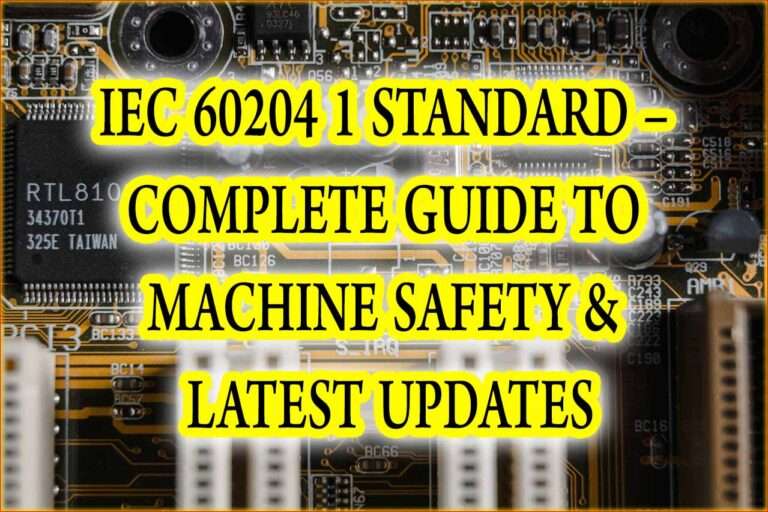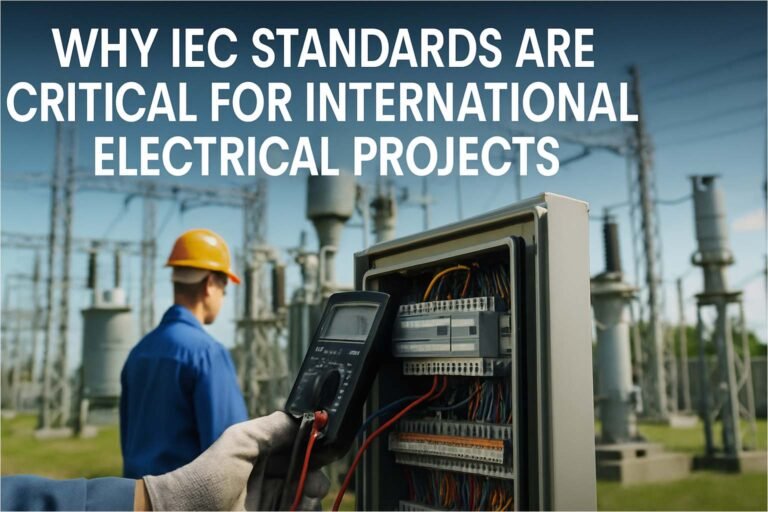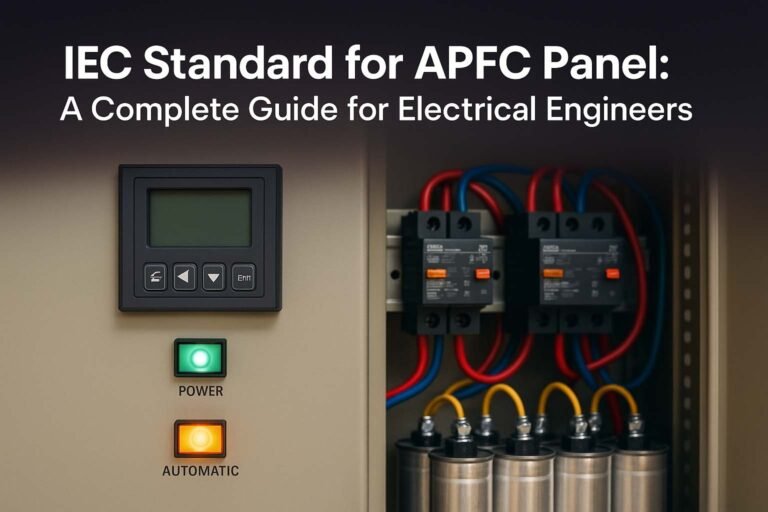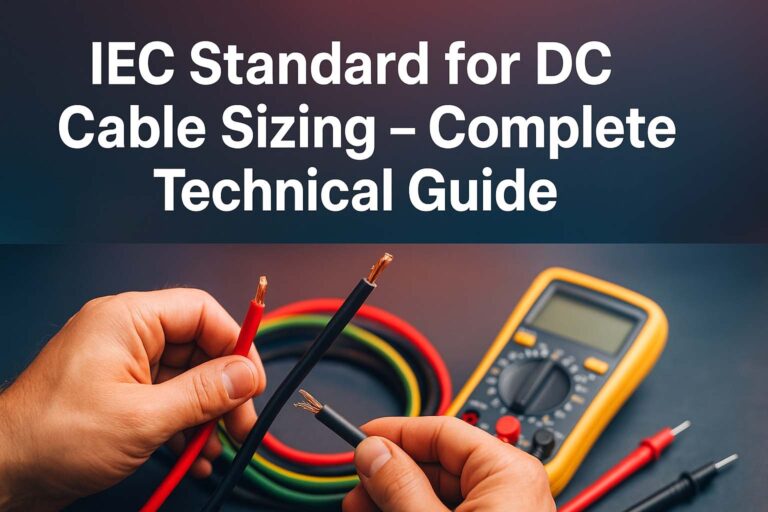IEC Standard for Gas Insulated Switchgear – IEC 62271 Compliance, Design & Safety Guide
The IEC standard for gas insulated switchgear (GIS) defines the global framework that ensures safety, reliability, and efficiency in high-voltage electrical installations. Gas insulated switchgear is widely used in substations, power plants, and industrial facilities where space constraints and environmental factors make traditional air-insulated systems impractical. Understanding the IEC standard for gas insulated switchgear is essential for engineers, designers, and maintenance teams who want to ensure compliance, performance, and long service life of their installations.
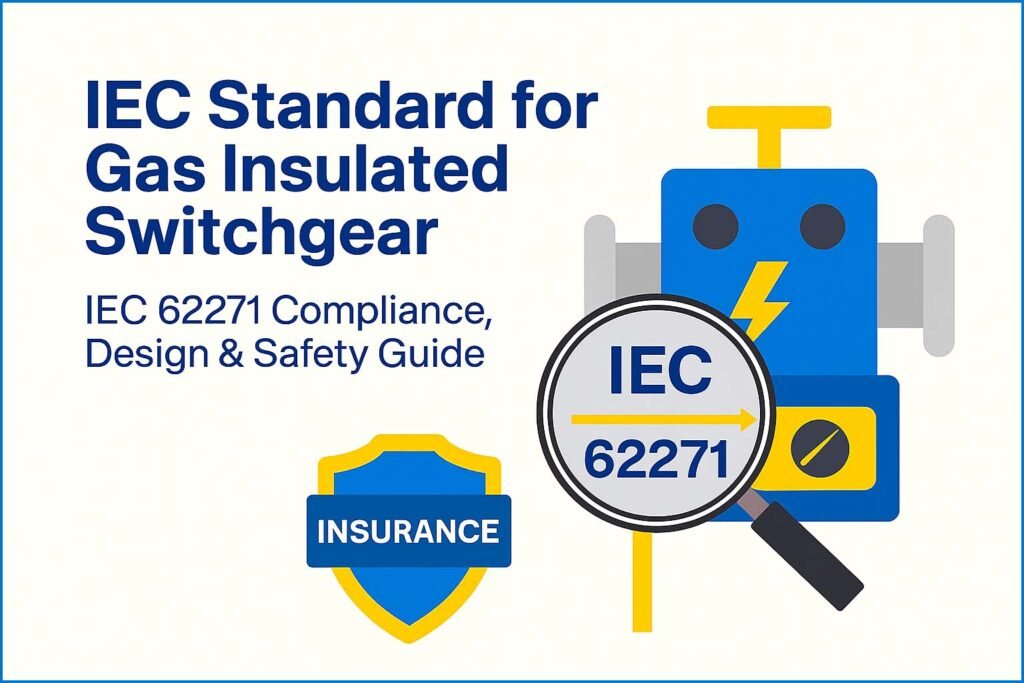
Table of Contents
What is Gas Insulated Switchgear
Gas insulated switchgear (GIS) is a compact metal-enclosed system that uses sulfur hexafluoride (SF6) or alternative insulating gases to isolate and protect electrical components such as circuit breakers, disconnectors, and busbars.
Unlike air-insulated switchgear (AIS), GIS offers high dielectric strength, compact design, and minimal maintenance. It is commonly used in high-voltage and extra-high-voltage networks where space, safety, and reliability are critical.
The technology behind GIS is based on encapsulating live parts within a metal housing filled with insulating gas. This gas prevents electrical discharges and maintains insulation integrity even in harsh environments.
Know more about IEC Standard for Creepage Distance – Electrical Insulation Requirements and Design Guide
Why IEC Standard for Gas Insulated Switchgear Matters
The IEC standard for gas insulated switchgear ensures that equipment used in power systems meets consistent quality and safety benchmarks worldwide. These standards define everything from design and testing to performance, installation, and maintenance. Following these standards not only enhances system reliability but also supports international compatibility and trade.
Compliance with IEC standards gives manufacturers and users confidence that the switchgear will perform safely under all expected operating conditions. It also ensures interoperability among equipment from different manufacturers.
Key IEC Standards for Gas Insulated Switchgear
Several IEC standards apply to gas insulated switchgear, depending on the voltage level and specific function of the equipment. The most important ones include:
| IEC Standard | Title | Scope |
|---|---|---|
| IEC 62271-203 | High-voltage switchgear and controlgear – Gas-insulated metal-enclosed switchgear for rated voltages above 52 kV | Specifies design, performance, and testing requirements |
| IEC 62271-200 | AC metal-enclosed switchgear and controlgear for rated voltages up to and including 52 kV | Applies to medium-voltage GIS |
| IEC 62271-100 | High-voltage alternating current circuit breakers | Defines circuit breaker requirements for GIS applications |
| IEC 62271-102 | High-voltage alternating current disconnectors and earthing switches | Covers isolator and earthing mechanisms used inside GIS |
| IEC 62271-1 | Common specifications for high-voltage switchgear and controlgear | Provides general safety and design rules for all switchgear types |
These standards work together to ensure every part of a GIS installation meets safety, performance, and environmental requirements.
IEC 62271-203 – The Core Standard for GIS
IEC 62271-203 is the most relevant IEC standard for gas insulated switchgear rated above 52 kV. It defines the design, construction, and testing requirements for GIS systems. The standard covers topics such as dielectric performance, temperature rise, short-circuit withstand capability, and internal arc classification.
Under IEC 62271-203, gas insulated switchgear must meet certain dielectric test requirements to ensure insulation reliability. It also specifies mechanical endurance tests for operating mechanisms and electrical endurance tests for circuit breakers. These tests guarantee that the equipment can handle high stress during faults and switching operations.
Know more about IEC Standard for Cable High Voltage Test: Best Guide
Design Requirements under IEC Standard for Gas Insulated Switchgear
The IEC standard for gas insulated switchgear defines several design requirements to ensure safety and performance. These include:
- Gas Tightness – The enclosure must be hermetically sealed to prevent gas leakage. The leakage rate must be extremely low, typically less than 0.5% per year for SF6 gas.
- Dielectric Strength – The insulating medium must withstand rated voltage levels and switching surges.
- Thermal Performance – The switchgear must handle rated currents without excessive temperature rise.
- Mechanical Strength – The metal enclosure must resist internal pressure and mechanical impact.
- Arc Protection – The GIS must be designed to contain and control internal arcing events.
These parameters are verified through rigorous type testing as defined by IEC 62271-203.
Testing According to IEC Standard for Gas Insulated Switchgear
Testing ensures that GIS meets the required electrical and mechanical performance. The IEC standard defines several categories of tests:
| Type of Test | Description |
|---|---|
| Type Test | Verifies design performance through high-voltage, thermal, and mechanical tests |
| Routine Test | Conducted on every unit before delivery to ensure manufacturing consistency |
| Special Test | Additional tests requested by the purchaser for specific conditions |
| Dielectric Test | Verifies insulation strength against high voltage |
| Gas Leakage Test | Ensures tightness of enclosures and gas compartments |
Each test plays a vital role in validating the reliability of gas insulated switchgear under various service conditions.
Know more about IEC Standard for DC Cable Sizing – Complete Technical Guide
Safety and Environmental Considerations
IEC standards place strong emphasis on operational safety and environmental sustainability. Gas insulated switchgear traditionally used SF6, a greenhouse gas with high global warming potential. IEC and industry standards now promote alternatives like fluoronitrile-based mixtures and vacuum insulation to minimize environmental impact.
The IEC standard for gas insulated switchgear also includes guidelines on safe handling, storage, and disposal of SF6 gas. It encourages manufacturers to design systems that are easy to monitor and maintain, ensuring minimal emissions throughout the product’s life cycle.
Advantages of Following IEC Standard for Gas Insulated Switchgear
Compliance with IEC standards ensures several key benefits for users and manufacturers:
- Improved system reliability and reduced risk of failure
- Standardized performance benchmarks across manufacturers
- Enhanced personnel safety through proven design and testing practices
- Global market acceptance and easier certification
- Long-term cost savings through reduced downtime and maintenance
In short, following IEC guidelines results in better-performing, safer, and more environmentally responsible switchgear systems.
Application Areas of Gas Insulated Switchgear
Gas insulated switchgear designed under IEC standards is widely used in several applications where space and reliability are key considerations. Common examples include:
- Urban substations with limited space
- Offshore wind and marine power systems
- Industrial facilities requiring high reliability
- Underground substations and tunnels
- Power generation plants and transmission nodes
Each application benefits from the compactness, safety, and long service life that GIS offers under IEC compliance.
GIS Calculator and Its Role in Design
To help engineers and designers comply with the IEC standard for gas insulated switchgear, a GIS calculator can be a powerful tool. This calculator estimates required parameters such as voltage rating, current capacity, gas pressure, and clearance levels according to IEC 62271-203 guidelines.
Know more about IEC Standard for DGA Analysis – Complete Technical Guide
By entering design inputs like rated voltage, system frequency, and environmental conditions, the calculator quickly provides recommended GIS specifications. It reduces design errors, improves efficiency, and ensures compliance with IEC standards.
For example:
| Parameter | Input | Output Based on IEC Standard |
|---|---|---|
| Rated Voltage | 132 kV | IEC 62271-203 Class GIS |
| Rated Current | 2500 A | Temperature rise ≤ 65°C |
| Insulating Gas | SF6 / Alternative | Leakage < 0.5% per year |
| Frequency | 50 Hz | Standard IEC frequency rating |
Such tools simplify the engineering process and make compliance easy even for complex installations.
Installation and Maintenance as per IEC Standard
IEC standards also guide the correct installation and maintenance practices for GIS systems. Proper installation ensures gas compartments remain sealed and electrical clearances are maintained. Periodic inspection and partial discharge monitoring are recommended to detect early signs of degradation.
The standard emphasizes using trained personnel and certified equipment for gas handling. Regular gas density monitoring and thermal imaging help prevent failures and extend service life.
Future Trends in IEC Standard for Gas Insulated Switchgear
As the power industry moves toward sustainability, IEC standards are evolving to include eco-friendly gases and digital monitoring. The next generation of GIS is expected to use low-GWP insulating gases, advanced sensors, and condition monitoring systems.
IEC committees are actively developing standards that support digital switchgear, predictive maintenance, and smart grid integration. This ensures GIS technology remains safe, efficient, and environmentally responsible for decades to come.
Know more about IEC Standard for Battery Charger – Complete Technical Guide
Conclusion
The IEC standard for gas insulated switchgear plays a crucial role in ensuring safe, reliable, and efficient power systems. It defines the benchmarks for design, testing, and performance that manufacturers and users must follow. Understanding and applying IEC 62271-203 and related standards ensures that GIS installations meet global expectations of safety, durability, and environmental responsibility.
With tools like the GIS calculator, engineers can easily design systems that comply with international standards while saving time and reducing errors. As technology evolves, the IEC framework continues to guide the transition toward sustainable and intelligent switchgear solutions for modern power networks.
Follow Us on Social:
Subscribe our Newsletter on Electrical Insights to get the latest updates in Electrical Engineering.
#IECStandard, #GasInsulatedSwitchgear, #GIS, #ElectricalEngineering, #SwitchgearStandards, #HighVoltage, #PowerSystems, #SubstationDesign, #IEC62271, #ElectricalSafety, #GridProtection, #EnergyInfrastructure, #SmartGrid, #PowerDistribution, #EngineeringStandards

